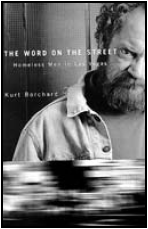Vicki Rice Kraeger
Writer
 When it comes to homelessness, “What happens in Vegas stays out of sight in Vegas.” That’s what Dr. Kurt Borchard, associate professor of sociology, found in doing research for his first book, “The Word on the Street: Homeless Men in Las Vegas.”
When it comes to homelessness, “What happens in Vegas stays out of sight in Vegas.” That’s what Dr. Kurt Borchard, associate professor of sociology, found in doing research for his first book, “The Word on the Street: Homeless Men in Las Vegas.”
The book was released in paperback in September. First published in 2005, the book evolved from his dissertation, which he completed in 1998. The book includes additional interviews and analysis of the homeless situation in Las Vegas.
While earning his doctorate at the University of Nevada, Las Vegas, Dr. Borchard began investigating homelessness in the city that relies heavily on tourism. In 1999, he determined that there were nearly 7,000 homeless people there.
For the book, Dr. Borchard did 48 interviews and observed homeless men in areas where they congregated, such as soup kitchens, shelters and public parks. He also did a content analysis of newspaper articles, signs and mailings from charities. He approached many different homeless people, told them about the project and had them sign an informed consent form if they wanted to participate in the project. Some were open to being involved, and some weren’t. Dr. Borchard said he learned that in Las Vegas, homeless people are systematically segregated away from tourist and residential areas. Homeless charities are centralized near North Las Vegas, in an area called the Homeless Corridor.
“Local resorts and casinos saw that as a good business decision, because they didn’t have homeless people in tourist areas as frequently,” he said.
When he was first in Las Vegas, Dr. Borchard said that he didn’t understand the spatial segregation. As he studied more, he looked at ways shelters had been developed in the space.
“Most tourists don’t realize the extent of homelessness in Las Vegas. Homelessness is kept out of the tourist eye,” he said. “Laws restrict panhandling on the strip, and security forces minimize the presence of the ‘undesirable.’”
Dr. Borchard had previously worked with homeless men at a shelter in Fairbanks, Ala.
“When I was at that shelter, I saw the difficulties those men had in ending their homelessness,” he said. “I began thinking, ‘What are the social conditions giving rise to homelessness?” Borchard took a sabbatical in 2005 and 2006, and went to Las Vegas to conduct more interviews for a book he is now working on about both homeless men and women in the city.
“In the second book, I’d like to show homelessness through more individualized detailed accounts of the people I’ve talked to.”